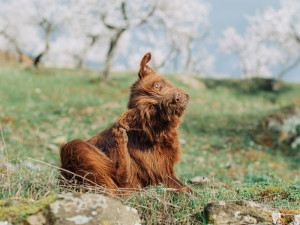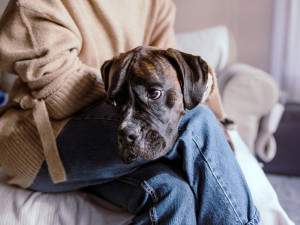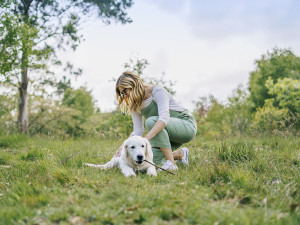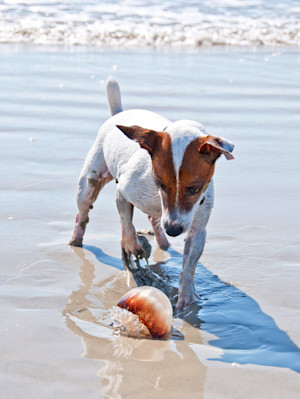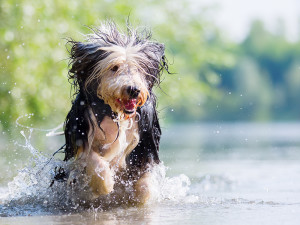When is it Too Hot to Walk Your Dog?
How to keep your dog safe, happy and active all summer long

share article
As the temperature rises, many dog parents face a common dilemma: how hot is too hot for dog walks? While exercise is crucial for your dog’s health and happiness, the summer heat can pose serious risks. During hot weather, dogs are at an increased risk of heat-strokeopens in a new tab, burnt paws and dehydration. Recognising the signs of overheating and knowing when to avoid outdoor activities is key to keeping heat-related hazards at bay.
The good news is that with a few adjustments to your routine, you can help keep your dog cool. By understanding when it’s too hot for a walk, recognising the symptoms of heat-stroke and employing strategies to keep your dog cool and active, you can ensure your pup stays safe and happy all summer long. Always prioritise your dog’s well-being over exercise routines and remember that sometimes, the best walk is no walk at all if it means keeping your canine companion out of harm’s way…
How do you know when it’s too hot to walk your dog?
Determining whether it’s too hot to walk your dog can sometimes be a challenging decision. The pull of taking your pup out for a walk can sometimes overtake checking to make sure it’s not too hot outside for your dog. Even if you feel comfortable in the (very rare) British heat, your pup is probably roasting, and that’s without considering that ground temperatures are higher than air temperaturesopens in a new tab in the daytime.
One practical and widely recommended testing method is the ‘five-second test’. Simply place the back of your hand on the pavement for five seconds; if it’s too hot for your hand, it’s too hot for your dog. The test not only helps to prevent paw burns, which are unfortunately common during peak summer, but also gives you an idea of the ground temperature over the general forecasted temperature.
That’s not to say overall air temperature isn’t a critical factor. Generally speaking, when the mercury reaches 20C, you should start being cautious. Even temperatures between 20–24C can put overweight or brachycephalic pups at risk of heat-stroke.
Anything above 25C can be dangerous, especially if the humidity is high, as it increases the heat index, making it feel hotter than it is. Dogs cool themselves primarily by panting and through the pads of their feet, which is not as effective as human sweating. Therefore, even if you feel only mildly uncomfortable, your dog might be struggling significantly more.
Beyond physical tests and temperature readings, watch for signs of discomfort in your dog during walks. These can include excessive panting, drooling or lagging behind. If you notice any of these signs, it’s best to return home and cool your dog down immediately by taking them out of direct sunlight and into a breezy, shaded area, and offering them small amounts of water.
Should you walk your dog in hot weather?
While skipping walks during hot weather might seem disappointing for both you and your dog, it’s crucial to consider the severe risks involved. As the PDSA recommendsopens in a new tab, “If in doubt, don’t go out.”
Walking your dog in high temperatures can lead to burnt paw pads and heat-stroke, a potentially fatal condition. Symptoms of burnt pawsopens in a new tab can include:
limping or refusing to walk
licking or chewing at the feet
pads darker in colour
missing part of pad
blisters or redness
Heat-stroke occurs when a dog’s body temperature rises to dangerous levels (not caused by a fever), and it can happen surprisingly quickly. Symptoms of heat-stroke in dogsopens in a new tab include:
heavy panting and rapid breathing
excessive drooling
red or purple gums and tongue
weakness, lethargy or collapse
vomiting or diarrhoea
confusion or dizziness
seizures
If you suspect your dog is suffering from heat-stroke, immediate action is required. Move your dog to a cool, shaded area, offer small amounts of water and wet their body with cool (not cold) water. It’s crucial to contact your vet immediately, as heat-stroke is an emergency.
Best practices for walking your dog during hot weather
When the weather warms up, adjusting your routine is essential to keep your dog safe. Here are some tips for managing walks during hot weather:
Walk early or late: schedule walks during the early morning or late evening when temperatures are cooler and pavements are less likely to burn your dog’s paws.
Take shaded routes: opt for walking paths that provide shade, such as wooded areas or parks with plenty of trees. This can help reduce your dog’s exposure to direct sunlight.
Carry water: always bring water for your dog and offer frequent breaks to ensure they stay hydrated.
Use cooling products: consider investing in cooling vests, bandanas or mats designed for dogs. These products can help lower your dog’s body temperature during walks, however, they shouldn’t be mistaken for a ‘fix’, and air temperature precautions should still apply.
Avoid hot surfaces: grass or dirt paths are preferable to tarmac or concrete, which can become extremely hot and hold a lot of heat, which can cause damage to your dog’s paws.
Alternatives to walks in hot weather
When it’s simply too hot for outdoor walks, there are plenty of ways to keep your dog active and entertained indoors or in shaded areas:
Indoor play: engage your dog with interactive toys, puzzlesopens in a new tab or a game of hide-and-seek to provide mental and physical stimulation.
Water activities: if you have the space and your dog enjoys water, a paddling pool or a garden sprinkler can be a fun and cooling activity. (Just ensure the water is not too cold, as sudden temperature changes can be harmful).
Training sessions: use the time indoors to work on obedience training or teach your dog new tricks.
Short, frequent breaks: instead of a long walk, opt for shorter, more frequent outdoor breaks for toilet needs and sniffs. This minimises exposure to heat while still providing necessary outdoor time.
References:
Dogs die in hot cars (and on hot walks) - PDSAopens in a new tab
PAW-ping hot! Five top tips for keeping furry friends safe in hot weather - PDSAopens in a new tab
8 steps to safely exercising your dog in hot weather - PDSAopens in a new tab
When is it too hot to walk a dog? - Vets Nowopens in a new tab

Orla Pentelow
Orla Pentelow is a freelance journalist and copywriter based in London. When not at her desk she’s out and about with her rescue dog, Luna, who works primarily as chief distractor.
Related articles
![A woman checking her dog for ticks outside in a grassy field.]() opens in a new tab
opens in a new tabLyme Disease in Dogs: What Every Dog Parent Should Know
We asked a vet for tips on how to prevent the tick-borne Lyme disease in dogs
![Jack Russell dog on beach looking at a jellyfish]() opens in a new tab
opens in a new tabA British Guide to the Countryside – For City Dogs
From thorns and grass seeds to more insidious threats such as snake bites and jellyfish stings, there’s a lot to watch out for
![Shepherd dog playing with yellow ball at the beach]() opens in a new tab
opens in a new tabIs My Dog Allowed On The Beach?
Check the rules before heading out…
![Bearded Collie running in a lake]() opens in a new tab
opens in a new tabWhen Drinking Too Much Water Is Deadly
How to keep your swimming dog safe

